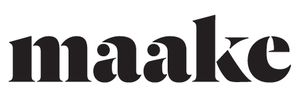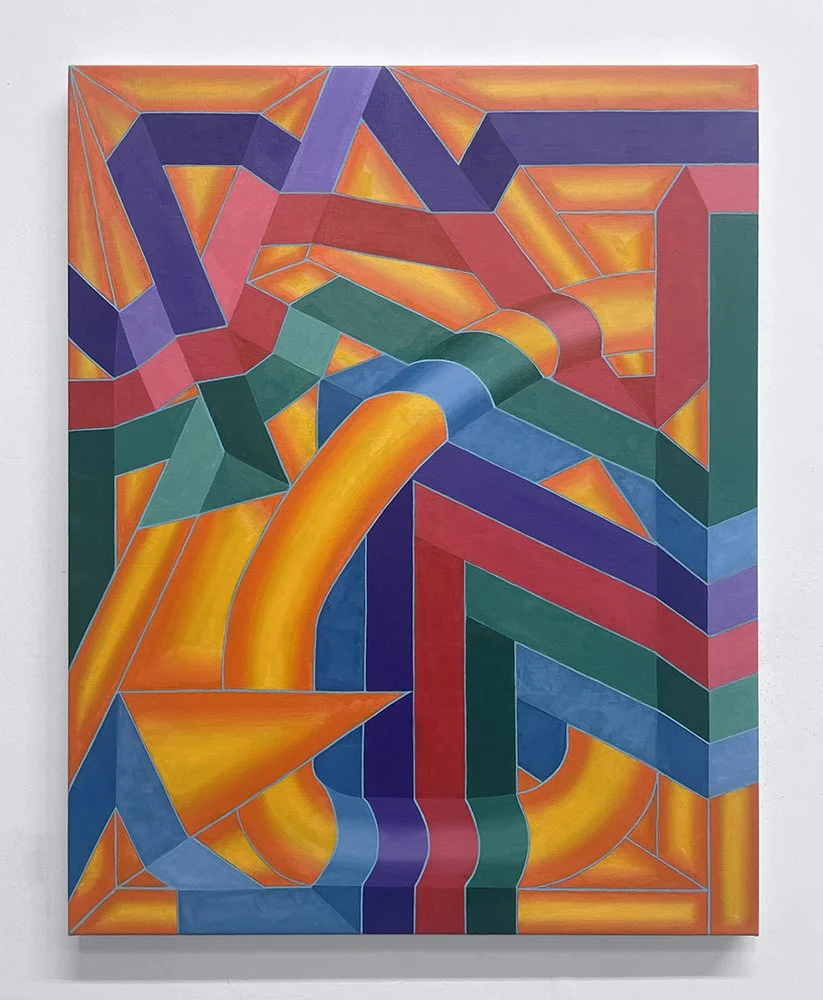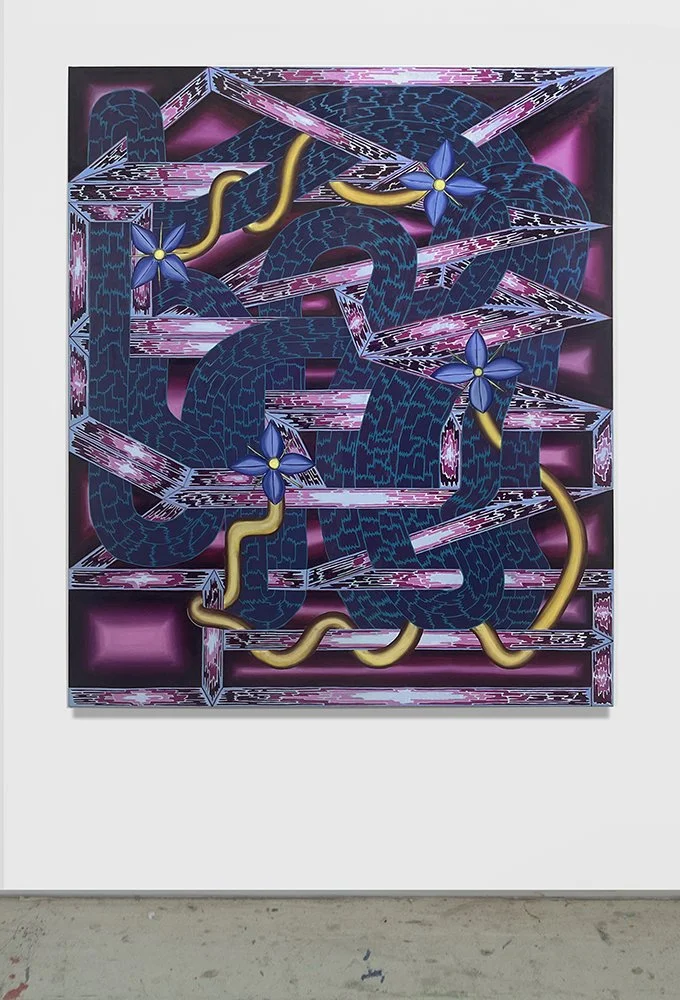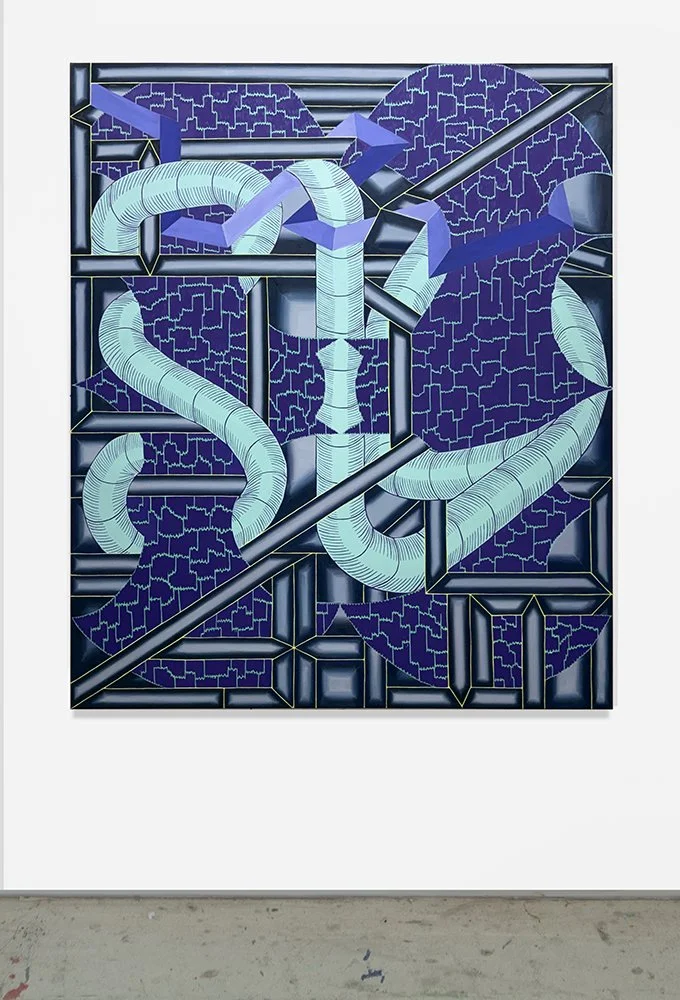Nicholas Moenich
Using a complex and personal visual language, the paintings weave figuration and abstraction to construct a psychological space. The paintings draw from a wide range of sources such as medieval illuminated manuscripts, modernist painting, comics, and various types of music. By emphasizing the frame and constraining the space within the paintings, shapes that suggest text or characters intertwine to examine the anxiety of the creative act and the passage of time. These fragmented compositions, which balance tangible material presence with believable pictorial space, serve as metaphors for our contemporary experience that revolves around the hyper-stimulated daily life of interconnecting media.
Fever (Bluff), 2024, oil on linen, 28 x 22 inches
Interview with Nicholas Moenich
Questions by Emily Carol Burns
Can you tell us a bit about your background and how you became interested in becoming an artist? Who or what were some of your most important early influences?
I grew up in Cleveland, Ohio. My father often took me fishing on Lake Erie and on trips to remote parts of northern Canada. Fishing requires a great deal of visualization—the goal is to lure unseen creatures from the depths. Imagining the underwater world and using lures to provoke a response shaped how I think about making art. I also came to see fishing as a fitting metaphor for life itself.
In my family there was always an emphasis on working with your hands, such as building, fixing, and cleaning things. I have an older brother, so I inherited his hand-me-downs: comic books and punk, metal, and rap albums, all of which shaped my aesthetic sensibility. At a young age, I began drawing and copying those album covers and comic book characters, especially Batman.
I was raised Catholic, and its dramatic imagery, especially depictions of the Saints, had an influence on me. It became an early gateway into art history. As a teenager, I worked at the Cleveland Museum of Art, which I still consider one of the best museums in the world.
Where are you currently based and what initially attracted you to working in this place? Are there any aspects of this specific location or community that have inspired aspects of your work?
I live and work in Bushwick, Brooklyn. When I first moved here in 2008 it reminded me of Cleveland—a desolate industrial zone with empty warehouses. It's a little bit different now. I like being in the city but it is important to get out into nature to reset.
Can you describe your studio space? What are some of the most crucial aspects of a studio that make it functional? Do any of these specific aspects directly affect your work?
My studio is down the street from my apartment. It is important to me to have a space that is separate from where I live but close enough that I get there easily at any time.
Ledge (Graft), 2024, oil on linen, 28 x 22 inches
What are you working on in the studio right now? What’s coming up next for you?
Paintings and drawings. I have a show of drawings opening at Picture Theory in NYC soon. I will have work in group shows in Chicago and Italy early next year.
What is on your mind a lot recently?
UFOs, interdimensional beings
What criteria do you follow for selecting materials? How long have you worked with this particular media or method? Can you walk us through your overall process? How long has this approach been a part of your practice? What are the primary themes of your work right now?
My current work builds on structures that emerged from an achromatic body of work I made between 2015 and 2022. That period began out of frustration—I cleared out my entire studio and started over from scratch. At first, I worked only with pencil on paper, imagining each drawing as a semi-abstract, cryptic show flyer for an alien punk band. I used the date of each drawing as a starting point. Over time, I began incorporating snippets of text and obscured, cartoonish forms such as cats and snakes.
Eventually, I wanted to engage more directly with the history of painting, so I began experimenting with acrylic on canvas. I was interested in creating something that felt psychedelic without relying on color—using only variations of black. These human-scale paintings explored the tension between large geometric structures and smaller, more organic shapes, creating a shifting figure-ground relationship that felt both hypnotic and spatially unstable.
That body of work became the foundation for where I am now. Gradually, I’ve been reintroducing more elements into my studio, both materially and conceptually, expanding my practice. I now work with the full spectrum of color in oil paint, building upon the formal vocabulary I developed in the earlier black-and-white pieces. I think of those earlier structures as a kind of scaffolding onto which color can be layered, draped, or suspended.
As the paintings evolve, my focus on color is transforming them into something like a phantasmagoric architecture—a dense, dream-like pictorial space with a strong material presence.
These forms help create a psychological space by playing with the ambiguity between figure and ground. The intertwined shapes evoke the suggestion of text or characters, and, together with the constrained space and emphasis on the frame, they explore themes of creative anxiety and the passage of time.
Golden Locks (Hybrid Moments), 2024, oil on linen, 68 x 56 inches
Can you talk about some of the ongoing interests, imagery, and concepts that have informed your process and body of work over time? How do you anticipate your work progressing in the future?
My paintings serve as physical metaphors for our contemporary experience, which is dominated by the constant flow of interconnected media and information. I recognize that my paintings contribute to this overload of stimuli, but my intention is also to create something visually compelling to reflect on the overwhelming nature of modern culture.
I let the work guide me. I believe in working through ideas by making. The process and materials determine what happens next. I approach my work systematically, so there’s a logic and structure behind every painting, even if nothing immediately recognizable appears.
Nosy Neighbors (The Nightmare), 2025, oil on linen, 68 x 56 inches
Do you pursue any collaborations, projects, or careers in addition to your studio practice? If so, can you tell us more about those projects, and are there connections between your studio practice and these endeavors?
The past couple years I have been collaborating with Glenn Goldberg on a calendar. It’s a conceptual project, mostly centered around photos and design. It is fun and enjoyable because it is completely different from how each of us normally work.
Teaching has also been a meaningful addition to my life. Since I began teaching in 2023, I’ve found it deeply fulfilling. It’s influenced my studio practice as well—particularly in how I think about color in my own paintings.
Can you share some of your recent influences? Are there specific works—from visual art, literature, film, or music—that are important to you?
The geometric forms and the dense space of my paintings are inspired by several influences, including the letterforms found in medieval illuminated manuscripts (such as the Book of Kells), album artwork and concert flyers (particularly in metal and rap music), and the modernist paintings of artists like Fernand Leger.
Sugar Time, 2024, oil on linen, 28 x 22 inches
Who are some contemporary artists you’re excited about? What are the best exhibitions you’ve seen in recent memory and why do they stand out?
Glenn Goldberg, Clinton King, Lauren Clay.
52 Walker’s recent wrestling show (Darby Allin, Raymond Pettibon, Charlie Ramone: 52W HARDWAY) was one of the greatest things to happen in a gallery ever.
Other favorites from this past year are Laura Owens at Matthew Marks, Randy Wray at Karma, the Siena show at the Met.
Thank you so much for talking with us!
To find out more about Nicholas and his work, check out his website.





